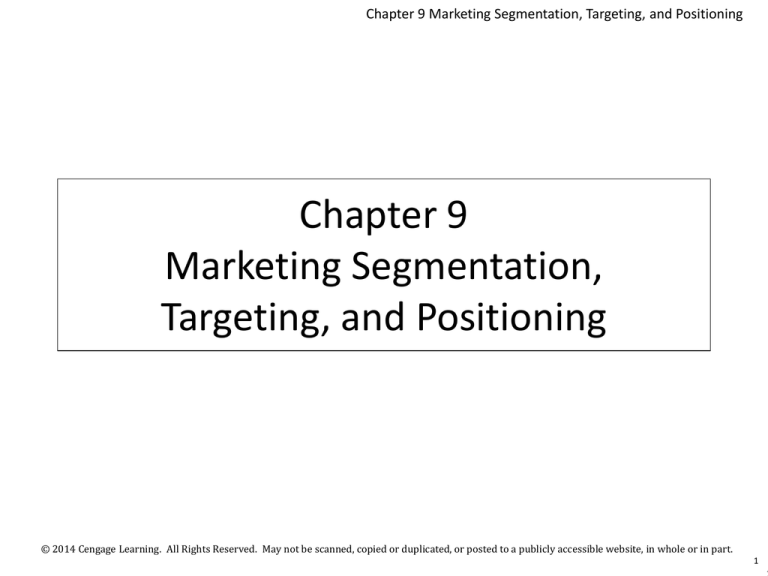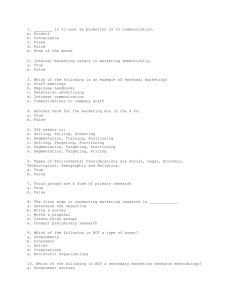
Chapter 9 Marketing Segmentation, Targeting, and Positioning
Chapter 9
Marketing Segmentation,
Targeting, and Positioning
© 2014 Cengage Learning. All Rights Reserved. May not be scanned, copied or duplicated, or posted to a publicly accessible website, in whole or in part.
1
Chapter 9 Marketing Segmentation, Targeting, and Positioning
Objectives
1. Identify the essential components of a
market.
2. Outline the role of market segmentation in
developing a marketing strategy.
3. Describe the criteria necessary for effective
segmentation.
4. Explain the geographic approach to
segmenting consumer markets.
© 2014 Cengage Learning. All Rights Reserved. May not be scanned, copied or duplicated, or posted to a publicly accessible website, in whole or in part.
2
Chapter 9 Marketing Segmentation, Targeting, and Positioning
Objectives
5. Discuss the demographic approach to
segmenting consumer markets.
6. Outline the psychographic approach to
segmenting consumer markets.
7. Describe product-related segmentation.
8. Identify the steps in the market
segmentation process.
© 2014 Cengage Learning. All Rights Reserved. May not be scanned, copied or duplicated, or posted to a publicly accessible website, in whole or in part.
3
Chapter 9 Marketing Segmentation, Targeting, and Positioning
Objectives
9. Discuss four basic strategies for reaching
target markets.
10.Summarize the types of positioning
strategies, and explain the reasons for
positioning and repositioning products.
© 2014 Cengage Learning. All Rights Reserved. May not be scanned, copied or duplicated, or posted to a publicly accessible website, in whole or in part.
4
Chapter 9 Marketing Segmentation, Targeting, and Positioning
Introduction
• Market - Group of people with sufficient
purchasing power, authority, and willingness
to buy
• Target market - Group of people a firm
believes is most likely to buy its goods and
services
• Types of markets
– Consumer products: Consumer’s personal use
– Business products: Resale purposes
© 2014 Cengage Learning. All Rights Reserved. May not be scanned, copied or duplicated, or posted to a publicly accessible website, in whole or in part.
5
Chapter 9 Marketing Segmentation, Targeting, and Positioning
Market Segmentation
• Division of the total market into smaller,
relatively homogenous groups
• Criteria for effective market segmentation
– Measurable purchasing power and size
– Promote and serve the market segment effectively
– Sufficiently large
– Aim for segments that match its marketing
capabilities
© 2014 Cengage Learning. All Rights Reserved. May not be scanned, copied or duplicated, or posted to a publicly accessible website, in whole or in part.
6
Chapter 9 Marketing Segmentation, Targeting, and Positioning
Segmenting Consumer Markets
Geographic segmentation
Demographic segmentation
Psychographic segmentation
Product-related segmentation
© 2014 Cengage Learning. All Rights Reserved. May not be scanned, copied or duplicated, or posted to a publicly accessible website, in whole or in part.
7
Chapter 9 Marketing Segmentation, Targeting, and Positioning
Geographic Segmentation
• Government now classifies urban data using
several categories
– Core based statistical area (CBSA)
– Metropolitan statistical area (MSA)
– Micropolitan statistical area
– Consolidated metropolitan statistical area
(CMSA)
– Primary metropolitan statistical area (PMSA)
© 2014 Cengage Learning. All Rights Reserved. May not be scanned, copied or duplicated, or posted to a publicly accessible website, in whole or in part.
8
Chapter 9 Marketing Segmentation, Targeting, and Positioning
Demographic Segmentation
• Division of an overall market into
homogeneous groups based on variables such
as:
– Gender and age
– Income and occupation
– Education
– Sexual orientation
– Household size
– Stage in the family lifecycle
© 2014 Cengage Learning. All Rights Reserved. May not be scanned, copied or duplicated, or posted to a publicly accessible website, in whole or in part.
9
Chapter 9 Marketing Segmentation, Targeting, and Positioning
Segmenting by Gender and Age
• Lines blurring in recent years
– Example: Men buying skin-care products and
women buying power tools and trucks
• School-age children have significant influence
over family purchases
• Tweens and teens influence billions of dollars
of family purchases
• Generation X(1968-1979) prefer goods and
services that support certain causes
© 2014 Cengage Learning. All Rights Reserved. May not be scanned, copied or duplicated, or posted to a publicly accessible website, in whole or in part.
10
Chapter 9 Marketing Segmentation, Targeting, and Positioning
Segmenting by Age
• Baby boomers (1946-1964): Popular because
of their numbers and income levels
• Seniors - High discretionary income, home
ownership, and spend money conservatively
• The cohort effect (1970-early 1990)
– Generation Y, the Millennial Generation,
Generation Next, Echo Boomers, and the 9–11
Generation
– Video Game Generation
© 2014 Cengage Learning. All Rights Reserved. May not be scanned, copied or duplicated, or posted to a publicly accessible website, in whole or in part.
11
Chapter 9 Marketing Segmentation, Targeting, and Positioning
Hispanics and African Americans
• Largest racial/ethnic minority groups in the
United States
• It is a challenge to reach Hispanic consumers
and turn them into customers
© 2014 Cengage Learning. All Rights Reserved. May not be scanned, copied or duplicated, or posted to a publicly accessible website, in whole or in part.
12
Chapter 9 Marketing Segmentation, Targeting, and Positioning
Asian and Native Americans
• Asian Americans are an attractive target for
marketers
– Have the fastest-growing income
• Native Americans constitute 1.7 percent of the
total U.S. population
• People of mixed race are growing in numbers
© 2014 Cengage Learning. All Rights Reserved. May not be scanned, copied or duplicated, or posted to a publicly accessible website, in whole or in part.
13
Chapter 9 Marketing Segmentation, Targeting, and Positioning
Segmenting by Family Life Cycle Stages
• Family lifecycle - Process of family formation
and dissolution
• Once children are on their own married
couples enter the empty nest stage
• Boomerangs - Grown children who have
returned home to live with their parents
© 2014 Cengage Learning. All Rights Reserved. May not be scanned, copied or duplicated, or posted to a publicly accessible website, in whole or in part.
14
Chapter 9 Marketing Segmentation, Targeting, and Positioning
Segmenting by Household Type and
Income and Expenditure Patterns
• Growing number of same-sex couples who
share households
• Engel’s laws - As household income increases:
– A small percentage of expenditure goes for food
– Percentage spent on housing, household
operations, and clothing remains constant
– Percentage spent on other items increases
© 2014 Cengage Learning. All Rights Reserved. May not be scanned, copied or duplicated, or posted to a publicly accessible website, in whole or in part.
15
Chapter 9 Marketing Segmentation, Targeting, and Positioning
Demographic and Psychographic
Segmentation
Demographic Segmentation
Psychographic Segmentation
• International Programs
Center (IPC) - Source of
global demographic
information
• Division of population
into groups having
similar attitudes, values,
and lifestyles
• AIO statements - Items
on lifestyle surveys that
describe various
activities, interests, and
respondents’ opinions
– Provides a searchable
online database of
population statistics
© 2014 Cengage Learning. All Rights Reserved. May not be scanned, copied or duplicated, or posted to a publicly accessible website, in whole or in part.
16
Chapter 9 Marketing Segmentation, Targeting, and Positioning
Psychographic Segmentation of Global
Markets
•
•
•
•
•
•
Strivers - Value professional and material goals
Devouts - Value duty and tradition
Altruists - Value societal well-being
Intimates - Value personal relationships
Fun seekers - Focus on personal enjoyment
Creatives - Seek education, technology, and
knowledge
© 2014 Cengage Learning. All Rights Reserved. May not be scanned, copied or duplicated, or posted to a publicly accessible website, in whole or in part.
17
Chapter 9 Marketing Segmentation, Targeting, and Positioning
Product-Related Segmentation
• Segmenting based on:
– Benefits people seek when they buy a product
– Usage rates for a product
– Brand loyalty toward a product
• Segmenting with multiple bases
– Combining geographic and demographic
segmentation techniques with segmentation by
income and expenditure patterns
© 2014 Cengage Learning. All Rights Reserved. May not be scanned, copied or duplicated, or posted to a publicly accessible website, in whole or in part.
18
Chapter 9 Marketing Segmentation, Targeting, and Positioning
The Market Segmentation Process
•
•
•
•
Develop a relevant profile for each segment
Forecast market potential
Forecast probable market share
Select specific market segments
© 2014 Cengage Learning. All Rights Reserved. May not be scanned, copied or duplicated, or posted to a publicly accessible website, in whole or in part.
19
Chapter 9 Marketing Segmentation, Targeting, and Positioning
Strategies for Reaching Target Markets
Undifferentiated marketing
Differentiated marketing
• Strategy that focuses on
producing a single
product and marketing
it to all customers; also
called mass marketing
• Strategy that focuses on
producing several
products and pricing,
promoting, and
distributing them with
different marketing
mixes designed to
satisfy smaller
segments
© 2014 Cengage Learning. All Rights Reserved. May not be scanned, copied or duplicated, or posted to a publicly accessible website, in whole or in part.
20
Chapter 9 Marketing Segmentation, Targeting, and Positioning
Concentrated Marketing and
Micromarketing
• Concentrated marketing - Focuses its efforts
on profitably satisfying a single market
segment
• Micromarketing - Targeting potential
customers at very narrow, basic levels such as
by Zip code, specific occupation, or lifestyle—
possibly even individuals themselves
© 2014 Cengage Learning. All Rights Reserved. May not be scanned, copied or duplicated, or posted to a publicly accessible website, in whole or in part.
21
Chapter 9 Marketing Segmentation, Targeting, and Positioning
Selecting and Executing a Strategy
• Basic determinants of marketing strategy
– Company resources
– Product homogeneity
– Stage in the product lifestyle
– Competitors’ strategies
© 2014 Cengage Learning. All Rights Reserved. May not be scanned, copied or duplicated, or posted to a publicly accessible website, in whole or in part.
22
Chapter 9 Marketing Segmentation, Targeting, and Positioning
Positioning
• Placing a product at a certain point or location
within a market in the minds of prospective
buyers
• Possible approaches
– Attributes
– Price/quality
– Competitors
– Application
– Product user/class
© 2014 Cengage Learning. All Rights Reserved. May not be scanned, copied or duplicated, or posted to a publicly accessible website, in whole or in part.
23








